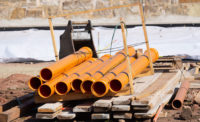By Debra K. Rubin, Eydie Cubarrubia, Justin Rice, Scott Van Voorhis, Jeff Yoders, Erica Berardi, Mark Shaw, Louise Poirier and Scott Judy
Questions about worker safety mounted as construction projects continued in New York after an industry first ruled “essential” by Gov. Andrew Cuomo (D) in mid-March was ordered to largely shut down by month’s end.
Cuomo revised his executive order on March 27, restricting that label to transportation and utility projects, health care facilities, affordable housing and work to close jobsites safely with all other constructon stopped immediately.
New York also now mandates distancing protocols for workers on essential or emergency projects. At press time, the governor’s most recent directive will last until April 28.
The Buildings Dept. announced March 30 that project teams in the city may be fined up to $10,000 per violation, starting March 31. The agency is “ready to enforce this critical ban on non-essential construction to help protect New Yorkers during this pandemic,” says Commissioner Melanie E. La Rocca. “At the same time, we will be out in force inspecting sites so that emergency and necessary construction work continues in a safe manner. Anyone breaking these rules should expect stiff enforcement.”
The extreme COVID-19 situation in the New York City metro area has been reflected in jobsite staffing, say contractor executives.
“We saw a big drop-off in manpower on March 23, plus or minus 50%,” says the CEO of one nonunion building CM firm who did not want to be named. “But it did rebound a little as the week went on,” the CEO says. “We had one site close for a short period to do a deep clean after an on-site worker tested positive. But all our other sites are working.”
According to a site manager at a major city transportation project, who also requested anonymity, “currently we are seeing around 80% of workers showing up to work.” A spokesman for the city School Construction Authority confirmed to ENR that it is now shutting down 670 projects.
Despite initial “heightened hygiene protocols, like an increased number of hand-washing stations, and earnest attempts at social distancing, in recent days, we began to see trades and subcontractors walking off jobsites temporarily or unable to supply sufficient labor force to keep projects moving forward,” says Linda Foggie, senior vice president of CM consultant Turner & Townsend and head of its New York City office. “Many of our [owner] clients are concerned with obligations outside the scope of their project that will be impacted by the schedule challenges they will face.”
But Lou Coletti, president and CEO of the New York Building Trades Employers Association, notes that contractors still need clarification on owner authority to shut down projects and whether subcontractors ordered to keep working despite being unable to meet social distance mandates could be fined.
“Providing clarity is an ongoing process,” he says. “But it’s critical that contractors have a clear understanding of what’s being required—for its work force and for the economic consequences.”
One CM firm project manager with at least eight ongoing NYC building projects says: “Workers were grateful for the measures that we took.” But the manager fears “this shutdown will have a profound impact on all of us. On an average day, our sites employ close to 2,000 union and nonunion workers. The layoffs started this afternoon already.”
Other Stoppages Continue
The city of Boston and the state of Pennsylvania, which both announced construction shutdowns nearly two weeks ahead of New York’s, remain mostly locked down for now.
In Massachusetts, a rift between Boston Mayor Martin J. Walsh (D) and the commonwealth’s Gov. Charlie Baker (R) over how construction activity should proceed during the pandemic sent mixed signals to contractors and owners.
After Walsh banned all but essential construction on March 16, a Baker administration letter sent to municipalities on March 25 said the governor’s decision to classify construction as an “essential service” in his stay-home advisory “makes inoperative any order or rule issued by a municipality” banning construction.
Walsh—a former union laborer and building trades leader—immediately extended Boston’s ban indefinitely, noting that “large gatherings such as those at construction sites have been proven to escalate the spread of the coronavirus.”
Several Boston contractors, including Suffolk, Gilbane and Consigli, said they supported Walsh’s ban, despite the fact that it impacts nearly 100 projects.
“People were obviously concerned because of the job losses, but I agree with it and thought it was a pretty gutsy move to be the first one to do it,” says Jim Kirby, chief executive of Commercial Construction Consulting (C3) in Boston.
Still, some say the edicts created confusion among contractors and unions. “I’m as confused as anyone about the different approaches to construction projects being taken by @marty_walsh and @MassGovernor,” tweeted Lou Antonellis, business manager and financial secretary for IBEW Local 103. “What about #SafetyFirst don’t you understand!”
Close and Open
In Pennsylvania, where mostly only hospital projects have been proceeding, Penn Medicine is rushing to complete a portion of its $1.5-billion Pavilion hospital project in Philadelphia 15 months ahead of schedule in order to open 119 rooms by mid-April for coronavirus patients.
The Pennsylvania Dept. of Transportation, which stopped all projects two days before the statewide construction ban, on March 31 activated 61 emergency and critical highway and bridge projects.
Elsewhere across the country, states and cities have enacted a patchwork system of varying stay-home orders that mostly allow at least some types of construction to continue.
For example, the stay-at-home orders in the Midwestern states of Illinois, Indiana, Ohio, Kansas, Minnesota and Wisconsin broadly exempt construction, while the state of Michigan is allowing only projects that qualify as “public works” to continue.
In Chicago, the Dept. of Veterans Affairs is now fast-tracking the previously halted $71-million Chicago Veterans Home project for possible use as a hospital once it’s completed.
Contractor IHC Construction was told to stop work on March 19, but then the VA reversed course and instructed the contractor to speed completion of the two-tower, 200-bed facility.
“The word on Friday was [we] have 21 days to complete it on an accelerated schedule,” says Joe Saftig, IHC Construction’s project manager.
The work force on site has nearly doubled, with the number of tradespeople increasing to roughly 130 from about 75. People are working Monday through Sunday and “as many hours as people can last,” Saftig says. “You wouldn’t believe there were more than 100 people in this five-story building because we have them so spread out.”
In Colorado, while a statewide stay-at-home order allows construction to proceed, work has been suspended on privately owned projects in some resort areas, and Pitkin County ordered that all work be stopped, including projects in Aspen, says AGC of Colorado CEO Michael Gifford.
In Nevada, Tony Illia, spokesman for the Nevada Dept. of Transportation, reports that all projects are still moving ahead. In fact, he says crews have been able to accelerate work in some areas due to the lighter traffic.
In California, most counties in the Bay Area, including San Francisco, jointly issued their most restrictive construction halt order yet on March 31, with limited exceptions for health care work only if related to COVID-19 response, affordable housing, certain public works projects and a handful of other project types.
Elsewhere in the state, projects meeting the criteria of “essential critical infrastructure” are continuing, but many other jobsites are being shut down.
“Currently, we are aware of grocery stores that are being halted and not deemed critical infrastructure” along with many other project types, says Peter Tateishi, CEO of AGC California.
Down South
In Texas, on March 29, Dallas County Judge Clay Jenkins issued a revised order that defines “critical infrastructure” as public works, residential, commercial and school projects.
In Austin, effective March 25, Mayor Steve Adler ordered nonessential business and operations to cease. Construction of public works, affordable housing and critical infrastructure projects were the only types exempted from the order.
The Austin chapter of AGC noted on March 30 that while public works projects are continuing, multifamily jobsites are shutting down unless considered to be affordable housing.
In Louisiana, the city of New Orleans, despite being considered a new epicenter for the pandemic, has deemed construction as essential. However, construction sites must maintain appropriate social distancing measures and meet other public health mandates, according to the city.
In South Florida—which is under a stay-home order issued by Gov. Ron DeSantis (R)—construction is mostly continuing apace. A group of construction industry associations—including the Builders Association of South Florida, AGC of South Florida, Florida East Coast ABC and the Latin Builders Association—has received signatures from 30 companies for a document outlining minimum safe working practices for jobsites.
Peter Dyga, spokesman with the Florida East Coast ABC, says it’s critical that firms work as safely as possible.
Says Dyga: “You can’t on the one hand say you’re ‘essential’ but not do what you need to be doing to make sure that the site’s healthy and employees are safe.”




Post a comment to this article
Report Abusive Comment